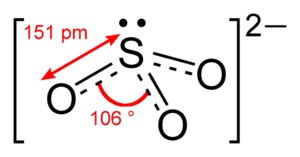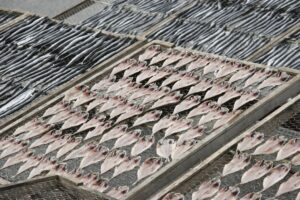 Sulphites (or sulfites, if you are American) are already an allergen of their own – so much so that in Canada they are considered a major allergen that must be reported on food products. Sulphites are a regular ingredient in wine production, so much so that finding wine without sulphites is uncommon. I heard a little while ago about people with glycol allergies being wary of dried fruits and vegetables produced using the sulphite process, and wanted to investigate further.
Sulphites (or sulfites, if you are American) are already an allergen of their own – so much so that in Canada they are considered a major allergen that must be reported on food products. Sulphites are a regular ingredient in wine production, so much so that finding wine without sulphites is uncommon. I heard a little while ago about people with glycol allergies being wary of dried fruits and vegetables produced using the sulphite process, and wanted to investigate further.
Drying:
 Fruits and vegetables can be dried via a number of different methods. Many add sugar to fruit. Dried fruit with no added sugar can actually be three to six times more expensive than frozen fruit, even for manufacturers making use of this dried fruit to make other products. Sulphites are commonly added to maintain the original colour of the fruit – brown and shrivelled is more what sulphite-free dried fruits and vegetables should look like. Most produce is washed in chlorinated water before drying, but the chlorine should readily evaporate during the drying process. Food nutrition after drying has not been thoroughly studied at this time, but the methods of drying are quite diverse:
Fruits and vegetables can be dried via a number of different methods. Many add sugar to fruit. Dried fruit with no added sugar can actually be three to six times more expensive than frozen fruit, even for manufacturers making use of this dried fruit to make other products. Sulphites are commonly added to maintain the original colour of the fruit – brown and shrivelled is more what sulphite-free dried fruits and vegetables should look like. Most produce is washed in chlorinated water before drying, but the chlorine should readily evaporate during the drying process. Food nutrition after drying has not been thoroughly studied at this time, but the methods of drying are quite diverse:
Freeze drying – No ingredients need to be added for this drying process. First, the produce is frozen. Next, it is placed in a vacuum chamber under low heat. The ice crystals in the food change directly from a solid to a gas, in the same way that ice cubes in your freezer slowly get smaller and smaller even though they’re not melting: Sublimation. The vacuum outside the food pulls this water vapour out of the food. This is one of the most costly methods of drying produce. The result is a piece of dried produce that usually maintains the original look and structure of the fresh produce, but very crunchy and dry. Dried produce manufactured using this method can be so dry that it pulls moisture from the air when left in an unsealed package and becomes more chewy.
Infused – A concentrated sugar solution is added to the fruit and the mixture is heated until the sugar moves into the fruit and the water evaporates. Sugar solution can be high fructose corn syrup.
 Sun-dried – Fruits can be sun dried easily, but vegetables that are high in acid and sugar are usually the only ones that can be sun-dried. They start by being washed, cut or cracked in some way to expose the highest-moisture part of the produce to the air, and then laid out on trays in the sun until dried.
Sun-dried – Fruits can be sun dried easily, but vegetables that are high in acid and sugar are usually the only ones that can be sun-dried. They start by being washed, cut or cracked in some way to expose the highest-moisture part of the produce to the air, and then laid out on trays in the sun until dried.
Drum dried – Often needs a carrier to be added to prevent sticking of the produce to the drum. A tumbling motion characterizes this method, where warm, dry air carries away moisture from the produce.
Air dried of tunnel-dried – Produce is set onto a screen or other porous platform and dried with the application of heat and good dry air currents.
Drying method really doesn’t seem to have any direct impact on what chemicals or extra ingredients are added in most cases; it all comes down to the manufacturer’s choice.

OLYMPUS DIGITAL CAMERA
Preserving Colour:
Sulphuring and sulphite dips (the sulphite process) are not the same thing. To sulphur produce, sulphur is burnt in an closed box, and the fumes penetrate the produce to prevent spoilage. This is a very old process. Sulphite dips are much faster, and involve a vat containing dissolved sodium bisulphite, sodium sulphite, or sodium meta-bisulphite. Produce is dipped into the vat and then dried by whatever method chosen. On packaging, this will be labelled as sulphur dioxide (due to the chemical processes that occur, the chemical changes). According to the FDA, only products containing more than 10 ppm, or 10 mg/L, are required to list sulphur dioxide on the label (in the US).
There are other methods of preserving colour in produce, but these are not as effective long-term, and are thus less used. Ascorbic acid (vitamin C) and sugar are both common preservatives. Ascorbic acid by itself is the most effective of these two, but ascorbic acid mixed with sugar, fruit juices that are high in ascorbic acid, honey, and sugar solutions are all valid options. Steam blanching is another method, using only water, that colour can be preserved, though flavour and texture can change.
Vegetables are more often just blanched by water or steam.
The most important thing I learned for sulphite allergy sufferers is that organic dried fruits do not contain sulphites, at least in North America and Australia.
What other ingredients are in dried produce?
Aside from the above-mentioned sugars, ascorbic acid, fruit juices, honey, sulphur, sulphites, and chlorinated water used to wash, some fruits, like raisins and berries, have a thin coating a vegetable oil applied to prevent them from sticking together. Any dried fruit or vegetable that is NOT organic can also contain pesticides and herbicides. I cannot find a concrete source of glycol in the drying or preserving process, though I am sure some manufacturers could find a reason to add it if desired.
So what in dried fruit might cause glycol allergy sufferers problems?
 Remember, dried fruit is fruit that has most of the water removed. Drying fruit does not remove its sugars or fibre. One single dried apricot contains all of the sugar and non-evaporating chemicals and plant structure of an entire apricot (plus any added sugars and chemicals). This means that if you eat ten dried apricots you are eating the equivalent chemicals of ten whole apricots. Even if one apricot’s chemical load didn’t bother you, ten might. I mentioned before about pesticides and herbicides being a possible source of glycol in non-organic produce, and this effect is amplified in dried produce because we eat more of it.
Remember, dried fruit is fruit that has most of the water removed. Drying fruit does not remove its sugars or fibre. One single dried apricot contains all of the sugar and non-evaporating chemicals and plant structure of an entire apricot (plus any added sugars and chemicals). This means that if you eat ten dried apricots you are eating the equivalent chemicals of ten whole apricots. Even if one apricot’s chemical load didn’t bother you, ten might. I mentioned before about pesticides and herbicides being a possible source of glycol in non-organic produce, and this effect is amplified in dried produce because we eat more of it.
From everything I can find, eating organic dried produce should eliminate any possible issues with either a sulphite or a glycol allergy, though it is always important to thoroughly read labels and be aware of their limitations. If you are really concerned about glycol or sulphites in your dried produce, the best way to ensure safety is to buy organic and dry it yourself. The links below should help with that.

Thanks again for another article pertaining to glycol. I so appreciate your blog!
I am now avoiding things processed with sunflower seed oil because I found myself becoming symptomatic after ingesting Craisins produced with sunflower seed oil.
http://www.healthy-eating-politics.com/vegetable-oil.html
Excerpt:
5. The seed pulp and oil are then put through a hexane solvent bath and steamed again to squeeze out more oil.
Note: Hexane is produced by the refining of crude petroleum oil.
In addition, you mentioned ascorbic acid as a preservative. While this is supposed to be vitamin C, I have concerns about the synthetic version;
http://www.precisionnutrition.com/all-about-vitamin-supplements
3. Strictly synthetic:
These nutrients are manufactured in a lab and are different than the same nutrients found in nature. Synthetic vitamins can have the same chemical constituents, but still have a different shape (optical activity).
This is important because some of the enzymes in the human body only work properly with a vitamin of the correct shape. When we give the body concentrated forms of synthetic nutrients, it doesn’t always appear to have an appropriate delivery system.
Starting materials for strictly synthetic supplements can be anything from coal tar to petroleum to acetylene gas. These supplements are made in facilities via chemical manipulations with the goal of duplicating the structure of the isolated vitamin.
Because of the relationship with petroleum, I am now avoiding the ingredient label “ascorbic acid”.
Hi Christie,
Thanks! I try to avoid using websites with alarmist tendencies or a clear, dollars-motivated agenda as references, but I can look through what you’ve shared.
With regards to sunflower oil, I fear there are too many things being mixed up here, and a few missing factors. The first article you shared pertains to the solvent-extraction method of obtaining some vegetable oils.
The article mentions hexane and lists symptoms of exposure to the gaseous form of hexane, but that is not the form that would be in the food – thus the exposure would be through ingestion rather than inhalation. Symptoms of hexane ingestion are nausea, vomiting, abdominal swelling, headache, and depression. (https://toxnet.nlm.nih.gov/cgi-bin/sis/search/a?dbs+hsdb:@term+@DOCNO+91) These aren’t good symptoms either, but we must consider the degree of impact of its use here. First of all, if there were harmful levels of hexane left over in the oils it would affect a large portion of the population. Poisoning affects people to different degrees, but a poison is a poison – it’s not as selective as allergies are. No separation is 100%, but the oils are heated to such a degree that there is minimal hexane remaining.
I don’t like the idea of having hydrocarbons in my food either, and don’t love the petrochemical industry as a whole (despite my direct experience with it), but I dislike alarmist viewpoints. There are many people with skin conditions who can only use highly-purified petroleum jelly on their skin due to allergies, and they report drastic skin improvements while using it. While I personally like to avoid petrochemicals, I cannot condemn every product that is based on dead, earth-processed plants and animals by painting them all with the same brush. We need to look at the actual hazards, benefits, method(s) of use, and effects of each one individually.
I am not partial to the solvent extraction method myself, but it is possible to enjoy these oils without them having been subjected to this level of processing by using expeller-pressed, CO2 extracted, or cold-pressed oils.
Finally, in relation to the craisins, there may be other factors at play here. Cranberries are not the most highly-contaminated fruit when it comes to pesticides and herbicides, but they are not at the bottom of the list either. Chemicals are used in commercial cranberry production to control fungus, pests, weeds, and other things that can interfere with large-scale production. (http://www.cranberries.org/sites/default/files/uploads/pdf/pesticide_use_021306.pdf) A pesticide/herbicide/etc does not contain 100% active ingredient – solvents, carriers, stabilizers, and preservatives are also used. Propylene glycol (and sometimes other glycols) are often a part of that mix. The same goes for the sunflower seeds before they are processed into oils. You could conceivably be reacting to the ingredients applied to your foods before harvest – something to consider further. Not everyone is that sensitive (to glycols), but I am. Eating organic minimizes that exposure for me.
I’m not going to address the entire topic of synthetic vs. naturally-sourced vs. naturally-occurring vitamins, but I will look at what you shared with regards to ascorbic acid. The article you shared actually doesn’t say anything all that negative against nature-identical synthetic vitamin C, which is what it says the majority of what is on the market is. It says that the vitamin C relies on other acids, but doesn’t even say for what. I think what it is trying to say is that the other ingredients (such as other acids) in the food products where vitamin C is naturally-occurring help the body to metabolize the vitamin C, so supplementing with it by itself leads to it being less bioavailable to the body. That should not be an issue with foods in which vitamin C is being used as a preservative, since you are not consuming the food in order to be able to gain more vitamin C in your body (or maybe you do want the vitamin C boost, but you get it from the fruit, not the added vitamin C). Not to mention that the fruit already does contain those necessary acids and nutrients to increase bioavailability of the vitamin C, so you might be getting more from it than you realize. The people who are most likely to have an issue here are people who are allergic to the materials, such as corn, from which the vitamins are derived. For those specific people, the source of those vitamins is a real concern.
I find it odd that they make a statement that naturally-derived vitamins should be only one chemical and that vitamin supplements that contain more than one isomer decrease bioavailability (still not a safety or contamination issue). That’s not the way naturally-occurring vitamins work. One isomer might be more bioavailable than others, but more than one occurs in nature and is in whole foods. The separation processes they mention that are used for each vitamin (they don’t explain vitamin C) may concern you, but again they say that most vitamin C on the market is not natural-source.
The comment that synthetic vitamins are of different forms than natural-source concerns me, as that is not true (with what appears to be the exception of vitamin E). Also they call optical activity and shape the same thing. Optical activity and shape are *not* the same thing. They seem to be trying to describe chirality. Shape is one factor, and that decides what chemical you actually have. Chirality itself is a complicated topic that I cannot discuss here without extending far beyond my already long reply, but Wikipedia has an explanation: https://en.m.wikipedia.org/wiki/Chirality_(physics) Having learned about these processes in classes, visited vitamin and pharmaceutical factories, and understanding chemistry, they often can’t synthetically manufacture one vitamin without also making its opposite chiral molecule. Luckily, in most cases these can be separated so that only the desired one is used. These separation processes are well-developed, as they are vitally important in the pharmaceutical industry where a difference in molecular chirality can result in the difference between something being beneficial or harmful. See above for my comments about condemning synthetically-produced chemicals across the board. We need to look at the nature of what is produced, not just where it comes from.
Check out this article about the bioavailability of natural-source vs. synthetic vitamins for more information:
https://www.scientificamerican.com/article/do-vitamins-in-pills-diff/
This still doesn’t make vitamin C bad.
The agenda of the second article as a whole is to promote eating foods to obtain nutrients, not supplement with vitamins, which I wholly support unless doing so is medically impossible or inadvisable. Again, eating vitamins for the purpose of supplementing diet is not the same as using ascorbic acid as a preservative.
Luckily ascorbic acid is only one of a number of possible preservatives used for dried fruits, so if you are uncomfortable with using one in particular, you can avoid that one in favour of fruits preserved using one of the other methods, such as sugar or ascorbic acid by way of fruit juice.
I hope this helps.
First, thank you for your very thorough explanation. Second, this has made me realize that I am not qualified to try to understand chemistry, lol. I am so grateful that the allergy community has those (like you) that can share their knowledge. My attempts to figure this all out may be a bit off track (it’s hard to research when one of my symptoms is brain fog, haha) and you’re right, I need to pay attention to what the website’s intentions are.
Take care,
Christie